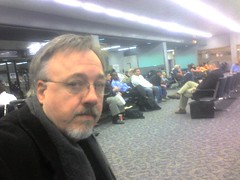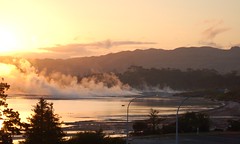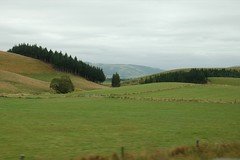There are only a few things that when I hear them, see them, smell them, feel them — make me unhappy. One of them is learning that I will follow Hall Davidson as a conference speaker. First of all, Davidson is very smart. He’s trained in improve, has a rich background, lives in Beverly Hill, talks fast, blah blah blah. Plus he always shows stuff that I was planning to present.
Month: February 2007
I’m Enthralled
 I’m sitting in a fabulous presentation by Discovery Educator Network’s Steve Dembo — but I am enthralled by they guy who’s sitting next to me. He pulls out his mobile phone and clicks a picture of Steve in action. He then clicks some buttons on the phone and slips it back in his pocket. Then he turns his attention to a tablet PC on his lap, touching the screen with his stylus, pulling up a Blogspot blog, including the photo’s that he is taking. Then he pops out a small window and scratches some text in a text box, his hand writing translating directly into text. I am so impressed!
I’m sitting in a fabulous presentation by Discovery Educator Network’s Steve Dembo — but I am enthralled by they guy who’s sitting next to me. He pulls out his mobile phone and clicks a picture of Steve in action. He then clicks some buttons on the phone and slips it back in his pocket. Then he turns his attention to a tablet PC on his lap, touching the screen with his stylus, pulling up a Blogspot blog, including the photo’s that he is taking. Then he pops out a small window and scratches some text in a text box, his hand writing translating directly into text. I am so impressed!
By the way, Steve Dembo completely whiled those attending the session!
Eric Langhorst about Social Studies and Technology
 I’ve virtually known Eric for several years. He was one of the very first k12 educators to have a podcast. Eric is a phenomenal social studies teacher, here in Missouri. He’s made several mentions of Web 2.0 and has given several examples of how he has used the Internet to connect his class with real experts. He convinced, via e-mail, one of the archeologists at the Jamestown excavation to interact with his class. His students became concerned, when a hurricane swept through the area. Their contact wrote back to them just after the storm explaining how they covered the dig. She wrote it from the floor of here kitchen, before the power was reconnected to her neighborhood.
I’ve virtually known Eric for several years. He was one of the very first k12 educators to have a podcast. Eric is a phenomenal social studies teacher, here in Missouri. He’s made several mentions of Web 2.0 and has given several examples of how he has used the Internet to connect his class with real experts. He convinced, via e-mail, one of the archeologists at the Jamestown excavation to interact with his class. His students became concerned, when a hurricane swept through the area. Their contact wrote back to them just after the storm explaining how they covered the dig. She wrote it from the floor of here kitchen, before the power was reconnected to her neighborhood.
Another connection was with two authorities on the Donner Party. His students held a debate about the guilt of the party leaders. He recorded their debate and e-mailed it to the authorities. They each sent back four pages of critique on each point that the students made. It’s about conversation!
Now this is interesting. Eric podcasted a phone interview with the author of a book that his classes were reading. He also had his student blog their conversations about the book. Interestingly, some of the parents and grand parents of his students read the book along with his students, and engaged in the blog discussions. Look back to my previous blog about School 2.0 and bouncing conversations out of the classroom and into communities.
Alas, I have to leave the session early for a conference call!
Before I shut down, Meg Ormiston did an amazing presentation about how we need to stop preparing students to be students, and prepare them, instead, for their future. Some great examples of students produced multimedia.
More on School 2.0
The dozens of hours I have recently spent in the air and the nights of half-sleep (inspired by mind numbing time-zone shifts) have given me time to think. The one topic that I have been presenting most consistently has been Web 2.0 — and it’s getting a bit stale. It’s still “edges of your seats” fun! But most everyone now knows what a blog is, wikis hold no mystery, we’ve gotten over wikipedia, and podcasting is no longer the “next big thing.” So what do educators need to know?
The question persists, “Is Web 2.0 going to lead to School 2.0?” Is it truly transformative, or just more geek lust and magic tricks for consultants to perform on stage for the applauds? It’s what I’ve been struggling with. I have been convinced for a long time that Web 2.0 is important, that it is affecting how we use information — which affects education. But in what ways? How might it transform what and how we teach?
It’s my nature to reduce things down to elevator speeches, to three bullet points, to a simple but illustrative diagram. I’ve said before that information, as a result of Web 2.0:
- Comes increasingly out of conversations that people have (blogs/wikis),
- Comes increasingly under the control of people who use it (RSS/Aggregators), and
- Comes to connect people through their ideas (blog linking and search engines)
Each of these characteristics is empowering. They empower us by valuing out ideas and stories, our ability and need to shape information for our needs, and our need to connect and communicate with other people who can help us do our jobs.
So what does this mean for education? I’ve been working through a diagram in my head about schooling 2.0. But first we should characterize the old school. It is important to state that our goals are not changing. We are, and always have been, tasked with helping our students develop the literacy skills, context of knowledge, and practical experiences so that they can prosper in their future. Nothing new here. However, as the market place, our children’s context, and the information landscape change, the skills, knowledge, and experiences that they need have changed.
 |
| Diagram 1 |
In school 1.0 (and especially during shifts into the negative realm that have resulted from the well intended but stifling affects of NCLB) teaching and learning are a game. David Williamson Shaffer characterizes games as consisting of roles and rules. Teacher’s and students practice roles and work within the constraints of rules. Teachers deliver content and skills, students are mirrors, reflecting content and skills back to the teacher (or government). If the reflection is in the image of the teacher and the state’s standards, then success has been achieved — regardless of any continuing affects on the students abilities to prosper in a rapidly changing time. (See diagram 1)
School 2.0’s greatest affect on teaching and learning is that it empowers both roles with a Yin and Yang affect. Teacher’s become learners and learners become teachers, and each side is empower with conversation, control over their information landscape, and connections with each other — with almost no constraints of hierarchy.
Students stop being mirrors, and instead become amplifiers. Their job is not merely to reflect what they encounter, but to add value to it. Content and skills are no longer the end product, but they become raw materials, with which students learn to work and play and share. Information is captured by the learner, processed, added to, remixed, and then shared back, to be captured by another learner/teacher and reprocessed. Each exchange and improvement not only runs on the energy of students (learner/teacher) curiosity and intrinsic need to play, work, and communicate information, but it also generates energy, which the teacher (teacher/learner) channels.
 |
| Diagram 2 |
As the energy builds, the activities, ideas, and content begin to re-vector out of the classroom and into the community, begging for attention and further participation. (see diagram 2)
Teachers and learners become information artisans, mining for information raw materials, remixing and re-networking what they find, and then communicating their new and valuable information products for re-mining. Teachers become learner models, and students become interactive learners developing and practicing life-long learning skills.
A while back, I was writing about a school that I had visited, where they were implementing a variety of Web 2.0 applications — and I suggested that, having removed some of the boundaries of the old school, they were still looking for new places upon which to get traction. I wonder now, if perhaps it is the students themselves where traction can be found — and if maybe that’s where it should have been all along. There is a certain amount of logic to teaching from standards. But there is no energy in standards. When classrooms become increasingly flat and we can no longer rely on gravity to drive learning — then we have to find new energy, and that energy is in our students.
Not To Happy
I Don’t look very happy here, do I? Due to delays in Washington last night, I ended out having about five hours at home, before jetting out again — today, it’s to St. Louis and the Midwest Educational Technology Conference. SO this is what David Thornburg and Ian Jukes feel like! Luckily, I slow way down in a couple of weeks.
I’m actual looking forward to this conference, having presented here a number of years ago. I’ll get to see Hall Davidson again, Wes Fryer, Gail Lovely, and many other conference regulars, including that bundle of creative energy, Meg Ormiston.
I’ll be doing sessions on podcasting and Web 2.0, and a Telling the New Story session for the leadership strand. I don’t know what kind of turn out I’ll have, since Wes has been there for a day already, and already done a podcasting workshop. He’s also dong the social networks session that was such a hit at the Texas state conference.
As a reminder, attendees and presenters at the METC should tag your blogs and flicker photos with metc07.
Technorati
Things Could Be Worse
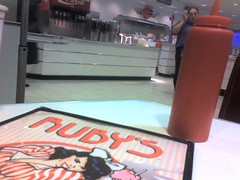
I’m sitting in a booth at Ruby’s. 1940s big band is playing over the speaker. Orders are being taken at he counter, and waitress is deliveing food with ample amounts of, “Any thing else, dear?”
A young woman sits at the counter, on a chrome stool, topped with candy-apple red vinyl. She does’t quite reach the foot bar., but seems to be enjoying her home fries.
Outside the window, I see three tail fins of jetliners, all sporting the logo for Song Airlines. You can find a place to retreat and sigh just about any where — even LAX.
Wireless Access Affects Online Behavior
A new report from PEW Internet in American Life reveals that..
Some 34% of internet users have logged onto the internet using a wireless connection either around the house, at their workplace, or some place else. *
In Wireless Internet Access, John Horrigan reports of all Internet users, 27% have logged on to the Internet wirelessly at places other than home or work, 19% have access to wireless networks at home, and 13% have PDAs (Personal Digital Assistants) that can access wireless networks. What is most interesting to me (and I’m not sure why yet) is the number of wireless Internet users who access the Net without cables from places other than home or work. Not surprising (given the cost of wireless routers) 88% of wireless users do so at home. However, more than half of wireless users (57%) access the Internet outside of home/work environments. This would include hotels, coffee shops and other service environments, libraries, and the growing number of municipal wireless regions.
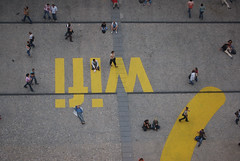 To me, this report points to increasing opportunities to access the Internet for information in more casual (not requiring direct wiring) contexts, and our predilection toward doing so. As someone who is interesting in determining the literacy skills we should be helping our children to develop, I am curious about what people do with wireless access to the Internet. Do they connect for a specific information experience, such as reading a particular blog or aggregation of blogs, or are they conducting research, googling a sudden topic of interest. Or are they doing work or homework.
To me, this report points to increasing opportunities to access the Internet for information in more casual (not requiring direct wiring) contexts, and our predilection toward doing so. As someone who is interesting in determining the literacy skills we should be helping our children to develop, I am curious about what people do with wireless access to the Internet. Do they connect for a specific information experience, such as reading a particular blog or aggregation of blogs, or are they conducting research, googling a sudden topic of interest. Or are they doing work or homework.
In other words, is this new. For years we’ve carried books with us to read at the coffee shop, under a tree, or on the train. We haven’t, however, carried encyclopedias around with us, and we haven’t made a habit of working so casually outside of the context of our workplaces. Does this really constitute a change in information behavior — an even deeper reliance on distant information?
The study did indicate that wireless users do tend to get their personal correspondence and new more regularly than do non-wireless users —
| Wireless | Home Broadband |
All Internet Users |
|
| E-mail Each Day | 72% | 63% | 54% |
| Get News Each Day | 46% | 38% | 31% |
* Horrigan, John. “Wireless Internet Access.” Reports: Internet Evolution. 25 Feb 2007. PEW Internet in American Life Project. 26 Feb 2007 <http://www.pewinternet.org/PPF/r/203/report_display.asp>.
Image Citation:
Laurent, Olivier. “Wifi.” Olivier C. Laurent’s Photostream. 22 Sept 2006. 26 Feb 2007 <http://flickr.com/photos/olivierclaurent/250099408/>.
Taking a Rest
 |
| People waiting for shuttles to hastily reserved hotel rooms in LA. |
I’d plan to take a bit of a rest before hitting the road again on Tuesday, but I’d hoped to do it home. Los Angeles is as far as I got, leaving the hotel in Dunedin, New Zealand at 1:30 PM today, and arriving at LA at about noon, and hour-and-a-half earlier. Cool! Weather is apparently rough in the north east, as far south as Washington, which is where I was suppose to fly through.
When I got to LAX, I learned immediately after clearing customs, that my flight across the country was canceled. I called Brenda and she had already booked me another flight early in the morning and a hotel room here in LA. Mission Control pulls through again.
I’ll fly home tomorrow, spend the night at home, and then fly west again to St. Louis for the Midwest Education Technology Conference. I’ve submitted it to Hitchhikr, and posted as the suggested tag, metc07. It seems that metc is already taken for a number of other issues. So if your coming to METC, tag your blogs and flickr photos with metc07.
Till then!
All That’s Left is Flying Home
| I’m all through in New Zealand. Yesterday’s workshop went well, though I have very little recollection of it — I am so jet-lagged. From the blog entries I’ve read so far, it seems to have gotten some people thinking. Greg Carroll organized the event, and he will be driving me back to the airport this afternoon. I hope that he will consent to a podcast interview on the road. I am just so bad at recognizing the great podcast opportunities at the right time. | 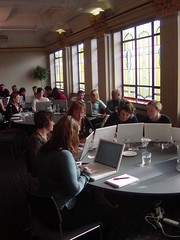 |
||
| Last night, I went to a rugby match with his family. I do not entirely understand the rules, but it was a lot like our football, except without the huddles and without the shoulder pads and helmets.
I still don’t know how they got the governor of California to play a highlander, the Dunedin team’s mascot. |
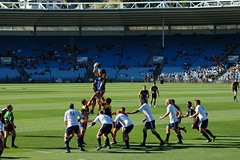  |
||
| Here is an all too typical picture of me, taken by Dragonsinger. It’s me not able to hear 😉 I have to look at you to hear you. Don’t know why. I don’t read lips. But what I hear is so garbled from not having an ear drum and all those boney things in my right ear, that I have to get clues from facial and body gestures. Not a problem. It’s just communicating.
You know, a lot of Kiwis use dragon in the names of their blogs. |
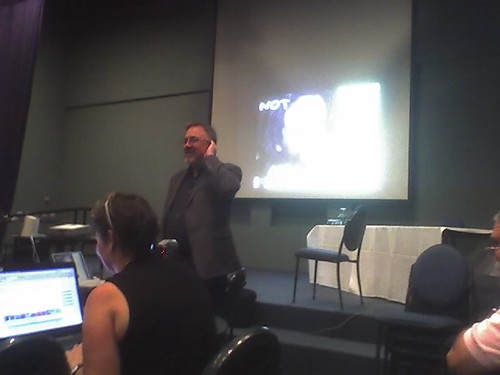 |
||
| “Conference Over.” Dragonsinger. 25 Feb 2007. 24 Feb 2007 <http://dragonsinger.edublogs.org/2007/02/23/conference-over/>.
|
|||
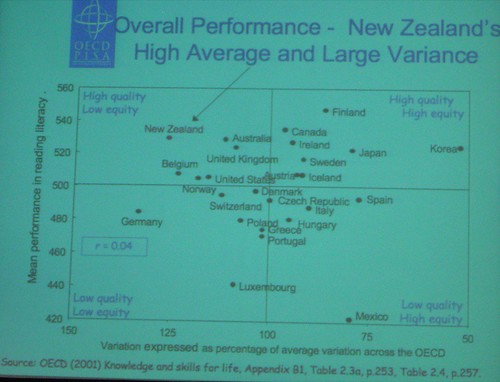 Finally, I have just moved into my computer, the photos that I took of Dr. Russell Bishop’s closing keynote address at the Learning@School conference. It was a very interesting address, that resonated with me from my U.S. point of view, regarding equity in education. His specialty is Maori education and the enequities that they are trying desperately to address. They have gone to heroic efforts to recognize and even identify with Maori culture as a nation, but native children continue to do very poorly in their schools. To the right is a slide that he included — quadrant regions for nations based on the quality of their education and the equity of their education. He includes references in the bottom of the slide, but I am not familiar with it — where the data comes from. Finally, I have just moved into my computer, the photos that I took of Dr. Russell Bishop’s closing keynote address at the Learning@School conference. It was a very interesting address, that resonated with me from my U.S. point of view, regarding equity in education. His specialty is Maori education and the enequities that they are trying desperately to address. They have gone to heroic efforts to recognize and even identify with Maori culture as a nation, but native children continue to do very poorly in their schools. To the right is a slide that he included — quadrant regions for nations based on the quality of their education and the equity of their education. He includes references in the bottom of the slide, but I am not familiar with it — where the data comes from.
Doesn’t look very flat to me. |
|||
Exhausted — but Still Standing
It seems that you have to hop along New Zealand. From Rotorua, I flew to Christchurch, and then from Christchurch, I flew the rest of the way to Dunedin. Flying home, I’ll catch a plane to Christchurch, then to Auckland, then (maybe) to Fiji, and then San Francisco, then Chicago, then Raleigh. Geez!
At any rate, I am very lucky to be here. What a beautiful city, tucked in the apparently ubiquitous mountains of the South Island. Once we broke cloud cover, my views out the window, of that very peculiar looking plane, were magnificent — mountains running right up to the coast of the Pacific. The city, again, is beautiful with wonderful vistas almost every direction that you look. I would show you the view outside of Greg Carroll’s dining room window, but I haven’t processed it yet.
Greg, a primary school principal and former cluster facilitator, is hosting my visit here, and the workshops I’ll be doing today here in the Mercure Hotel. It will be a relatively intimate event, with only about 50 attendees. I consider it a unique challenge, because the perspectives of educators here are quite different from that of most of my audiences. Here, if teachers like and idea that I suggest, they can say, “I can do this!” “I can’t wait!”
In the U.S., they will say, “How might I convince the powers-that-be that we should be doing this!” Of course, it’s not always that way, because there are certainly conspicuous pockets of courage and vision in the United States. But things are so different here.
Challenges remain! Just like the U.S., there seems to be a vexing digital divide between urban and rural locations, with regard to broadband. Though there city broad band is significantly higher than the U.S., it is also significantly slower than that in Japan and Korea. However, rural areas still rely on dial up.
I’d like to clarify one point from yesterday’s blog (or was it Thursday? Where do you live, anyway? 😉 It is so confusing!). I’d said that New Zealand does not enjoy an E-Rate style solution for making broadband access to information more affordable. However the government has set up, or funded a network called School Zone. For most schools, it gives them a discount, though not in all instances. They also provide e-mail for students and web-hosting services.
Much more that I could share, but I’d better conserve what capacities I have left in my brain — which is starting to feel like a spinning top!
[Again, if you are in New Zealand, and any of my statements need clarifying, please comment]

